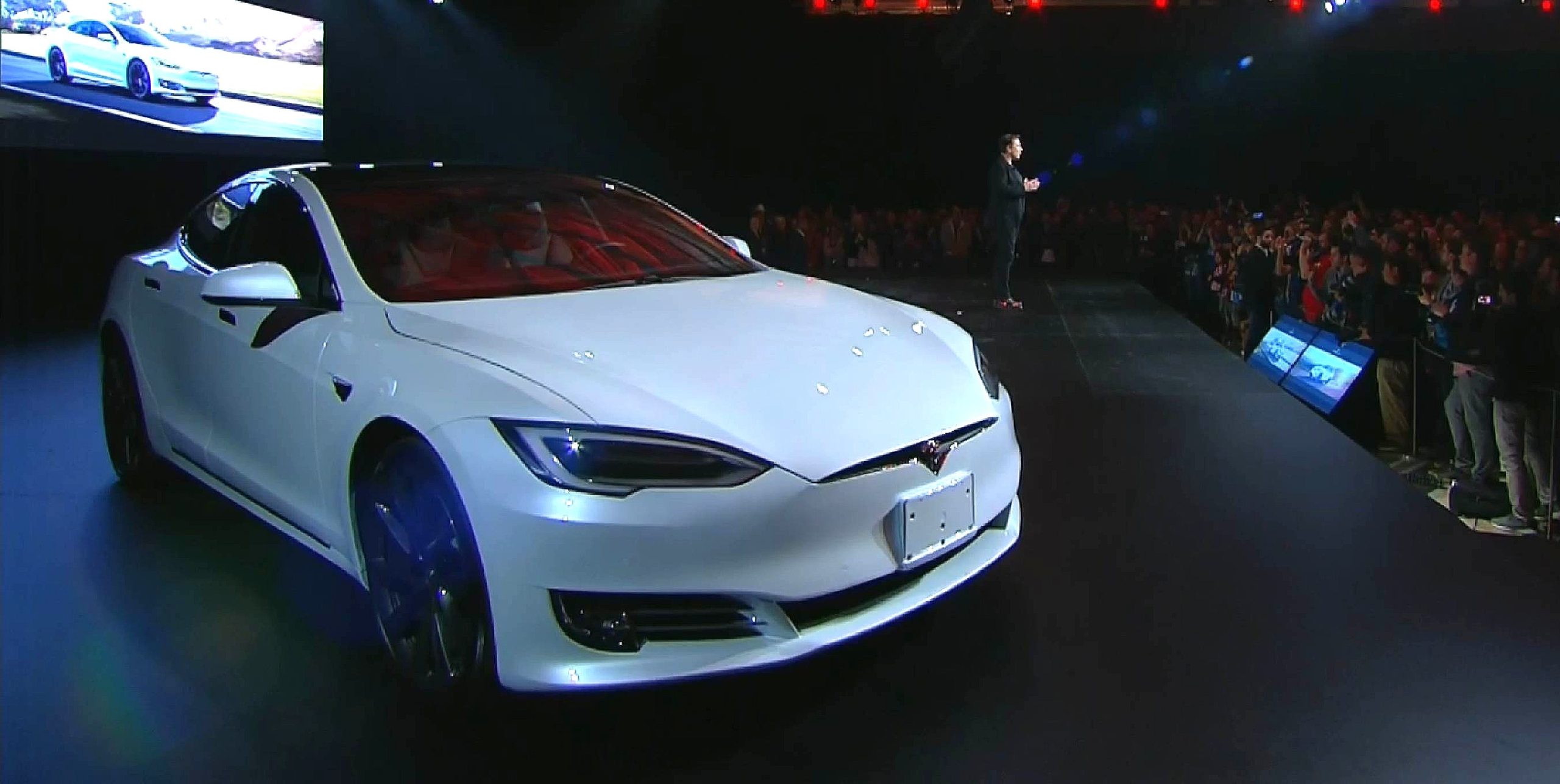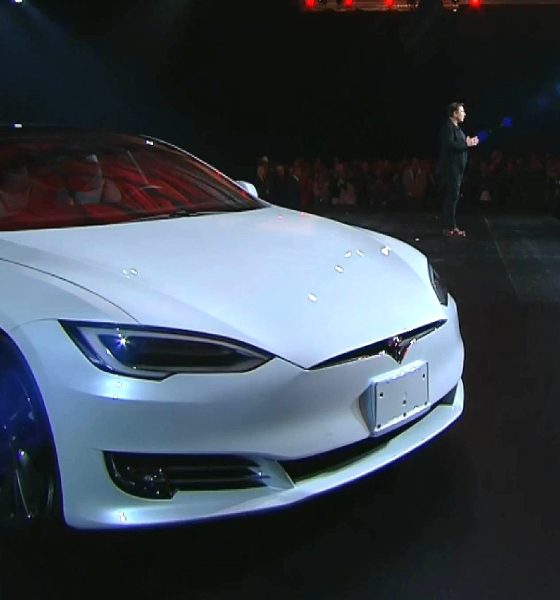

News
Tesla Model S ranked as luxury car with highest resale value in Germany
The Tesla Model S has outranked a number of Germany’s best luxury sedans in terms of resale value, according to the Schwacke list, which analyzes and ranks the approximate residual value of used motor vehicles in the German market. Following the Model S is the Porsche Panamera, and third on the list is the Audi A8.
Schwacke experts listed a three-year-old Tesla Model S with a mileage of 60,000 km (37,000 miles) with an impressive 60% residual value. In comparison, a Porsche Panamera was listed with a residual value of 57.4% after three years, and an Audi A8 was listed with a 54.1% residual value after a 36-month period. The Mercedes-Benz S-Class, one of the luxury market’s most iconic cars, was listed with a 51.9% residual value after three years.

The Model S’ ranking in Schwacke‘s list is a testament to the impresisve staying power of the large electric sedan, which has served as Tesla’s flagship for years. The Model S is Tesla’s first vehicle that was designed from the ground up, and it has mostly remained physically unchanged since 2012 when it entered production. The same could not be said of the Model S’ competitors in Schwacke‘s list.
Being some of the auto industry’s most noted premium electric vehicles, Teslas are known for their high resale values. The company’s vehicles share the same reputation in the United States, as shown by the results of Kelly Blue Book’s (KBB) 2019 Best Resale Value Award.
Last January, KBB listed the Tesla Model 3 at the top of the electric vehicle category in its 2019 listings, predicting a 69.3% resale value for the vehicle after 36 months and 48.7% after 60 months. Following the Model 3 is its stablemate, the Tesla Model X SUV, which was listed with a 56.7% resale value after 36 months and a 34.3% value after 60 months.
There are a number of reasons that can be attributed to the high resale values of Tesla’s electric cars. Among these include the uniqueness of the vehicles themselves, which is highlighted by their impressive performance, range, and safety. Other perks to the Tesla experience, such as the expansive and ever-growing Supercharger Network, as well as free over-the-air updates that add and improve features, also help the company’s vehicles retain their value over time.
When KBB awarded the Model 3 with the top rank in its 2019 list, the company mentioned that the electric sedan is an ideal vehicle for customers who can afford it. This sentiment is currently being addressed by Tesla, as could be seen in the introduction of the Model 3’s two most affordable variants, the Standard and Standard+ trims. Reports from the Tesla community have indicated that deliveries of Standard+ Model 3 are already starting. Confirmed deliveries of Standard Model 3 are yet to emerge, suggesting that Tesla might have pushed back the deliveries of its most affordable vehicle during its end of Q1 push in favor of the Standard+ Model 3.

Elon Musk
Elon Musk’s Biggest Revelations on AI, Robots, and the Future of Work from the Moonshots Podcast

Elon Musk’s appearance on the Moonshots with Peter Diamandis podcast was packed with bold predictions, candid admissions, and surprising tech insights. The nearly three-hour conversation covered everything from artificial intelligence to humanoid robots, geopolitics, and the future of work. Here are the top 10 most intriguing takeaways:
-
Aggressive AGI Timeline Predictions
Musk offered a detailed view on when artificial general intelligence (AGI) could emerge, suggesting it may arrive sooner than many expect, emphasizing both transformative potential and risks.
-
U.S. vs. China in the AI Race
He discussed the strategic competition between the United States and China over AI development, noting that geopolitical dynamics will shape how and who leads in the next decades.
-
Future of Job Markets
Musk touched on how AI and automation could reshape employment, predicting massive boosts in productivity alongside potential disruptions in traditional work structures.
-
Clean Energy Transition
A recurring theme was the role of clean energy in future economies, with Musk reiterating the importance of scaling sustainable power generation and storage.
-
Humanoid Robots Are Coming
On the podcast, Musk elaborated on Tesla’s work on humanoid robots, hinting at timelines and applications that go beyond factories to general-purpose assistance.
-
Tesla Roadster “Last Human-Driven Car”
Outside the core discussion topics, Musk teased features of the upcoming Tesla Roadster — calling it “the best of the last of the human-driven cars” and suggesting safety won’t be its main selling point.
-
The Role of AI in Clean Energy and Robotics
Linking AI to both energy optimization and robotics, Musk explained how smarter systems could accelerate decarbonization and task automation across industries.
-
U.S. Innovation Leadership
Musk argued that maintaining American leadership in key tech sectors like AI, space, and robotics should be a national priority, with thoughtful policy and investment.
-
Job Creation vs. Job Elimination
While acknowledging automation’s disruptive effects, he also outlined scenarios where new industries and opportunities could emerge, particularly in AI, space, and advanced manufacturing.
-
Long-Term Vision for Humanity
Throughout the conversation, Musk revisited his long-term philosophical views — including a belief in humanity’s responsibility to become a multi-planetary and technologically empowered species.
Whether you agree with Musk’s optimism or not, the podcast offers a window into the thinking of one of the most influential figures in tech today, in and why his visions continue to spark debate and inspiration.
Elon Musk
Elon Musk just said some crazy stuff about the Tesla Roadster

Elon Musk appeared on the Moonshots podcast with Peter Diamandis today to discuss AGI, U.S. vs. China, Tesla, and some other interesting topics, but there was some discussion about the upcoming unveiling of the Roadster, the company’s electric supercar that will arrive several years after it was initially slated for release.
Musk made some pretty amazing claims about the Roadster; we already know it is supposed to be lightning-fast and could even hover, if Tesla gets everything to happen the way it wants to. However, the car has some pretty crazy capabilities, some of which have not even been revealed.
On the podcast, Musk said:
“This is not a…safety is not the main goal. If you buy a Ferrari, safety is not the number one goal. I say, if safety is your number one goal, do not buy the Roadster…We’ll aspire not to kill anyone in this car. It’ll be the best of the last of the human-driven cars. The best of the last.”
🚨 Elon on the Roadster unveiling, scheduled for April 1:
— TESLARATI (@Teslarati) January 6, 2026
Musk makes a good point: people who buy expensive sports cars with ridiculous top speeds and acceleration rates do not buy them to be safe. They hope they are safe in case of an emergency or crash, but safety is not at the forefront of their thoughts, because nobody buys a car thinking they’ll crash it.
The Roadster is truly going to push the limits and capabilities of passenger vehicles; there’s no doubt about that. Tesla plans to show off the new version car for the first time on April 1, and Musk has only hinted at what is possible with it.
Musk said back in November:
“Whether it’s good or bad, it will be unforgettable. My friend Peter Thiel once reflected that the future was supposed to have flying cars, but we don’t have flying cars. I think if Peter wants a flying car, he should be able to buy one…I think it has a shot at being the most memorable product unveiling ever. [It will be unveiled] hopefully before the end of the year. You know, we need to make sure that it works. This is some crazy technology in this car. Let’s just put it this way: if you took all the James Bond cars and combined them, it’s crazier than that.”
Production is set to begin between 12 and 18 months after the unveiling, which would put the car out sometime in 2027. Hopefully, Tesla is able to stay on track with the scheduling of the Roadster; many people have been waiting a long time for it.
News
Tesla launches hiring for Robotaxi program in its twentieth country
Overall, the hiring signals Tesla’s aggressive timeline for global dominance in autonomous mobility.

Tesla has launched a hiring initiative for its Robotaxi program in its twentieth country, as the company posted two new jobs in Thailand this week.
Tesla is hiring in Bangkok and Kowloon for the Vehicle Operator position, which is related to data collection, and is the first in Thailand, but the twentieth country overall, as the company tries to expand into other markets.
🚨 BREAKING: Tesla is hiring additional full-time Vehicle Operators in Bangkok, Thailand.
Previous openings were 6-month, part-time roles. These are equivalent to AI Safety Operator roles in the U.S. pic.twitter.com/R6LzoU1bos— Tesla Yoda (@teslayoda) January 5, 2026
Tesla has had active job postings for Vehicle Operator positions in the United States, India, Israel, Taiwan, Germany, the Czech Republic, Hungary, the UK, Finland, Switzerland, Sweden, the Netherlands, Austria, Spain, Norway, Italy, and Turkey in past listings.
These postings are not all currently available, likely because the roles have been filled.
Thailand is the most recent, and broadens the company’s potential path to expanding its ride-hailing program, which is only active in the United States in Austin, Texas, and the California Bay Area, so far.
These roles typically involve data collection, which assists in improving Autopilot and Full Self-Driving operation. Tesla’s self-driving programs utilize real-world data that is accumulated and stored, observing vehicle and traffic behavior, as well as tendencies that are performed by human drivers to help increase safety and overall performance.
Overall, the hiring signals Tesla’s aggressive timeline for global dominance in autonomous mobility. Although the company has several high-profile rivals and competitors in the field, it has established itself as a main player and a leader in the development of autonomous technology, especially in the U.S., as its FSD suite is refined on almost a weekly basis.
The Full Self-Driving suite is available in seven countries and territories currently, including the U.S., Canada, China, Mexico, Puerto Rico, Australia, and New Zealand. Its biggest goal for expansion is currently the European market, where regulatory hurdles have been the main bottleneck prolonging its launch on the continent.
Tesla has performed months of testing in various European countries, including France and Spain, and does have support in some areas from various regulatory agencies. However, the company is hoping to get through this red tape and offer its suite in Europe for the first time, hopefully this year.








